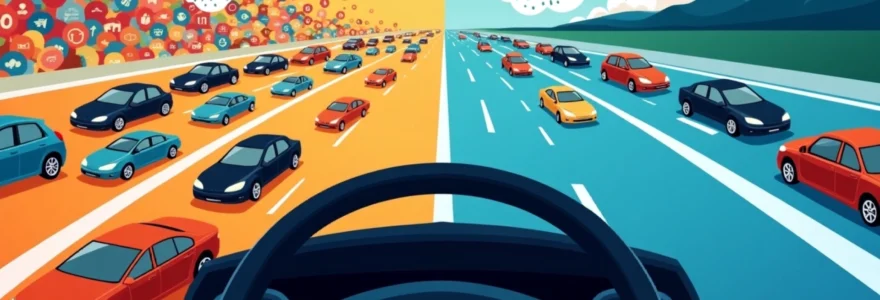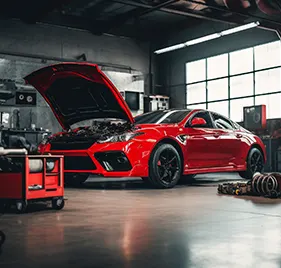Navigating through heavy traffic can be a daunting task for even the most experienced drivers. The daily grind of rush hour commutes often leads to increased stress levels, reduced focus, and potentially dangerous driving behaviors. However, with the right strategies and mindset, it's possible to transform these challenging situations into opportunities for calm, efficient, and safe travel. This comprehensive guide explores advanced techniques, cognitive approaches, and technological solutions to help you master the art of safe driving in congested conditions.
Traffic flow analysis and vehicle spacing techniques
Understanding traffic flow dynamics is crucial for maintaining safety and reducing stress in heavy traffic situations. By analyzing patterns and implementing effective vehicle spacing techniques, drivers can significantly improve their commuting experience. One key aspect of traffic flow analysis is recognizing the accordion effect, where small changes in speed can ripple through a line of vehicles, causing sudden braking and potential collisions.
To mitigate this effect, drivers should focus on maintaining a consistent speed and adequate following distance. This approach not only enhances safety but also helps to smooth out traffic flow, potentially reducing congestion for everyone on the road. Additionally, being aware of merge points and potential bottlenecks allows drivers to anticipate and adapt to changing traffic conditions more effectively.
Vehicle spacing techniques play a crucial role in managing traffic flow and reducing the risk of accidents. The most widely recognized method is the three-second rule, which involves maintaining a three-second gap between your vehicle and the one in front. This gap provides ample time to react to sudden changes in traffic conditions, reducing the likelihood of rear-end collisions.
Advanced defensive driving tactics in congested areas
Defensive driving takes on new dimensions when navigating through congested urban areas. Employing advanced tactics can significantly enhance safety and reduce stress levels during peak traffic hours. These strategies focus on proactive decision-making, situational awareness, and efficient vehicle control.
Implementing the smith system in heavy traffic
The Smith System is a well-established set of defensive driving principles that can be particularly effective in heavy traffic scenarios. This system encompasses five key rules:
- Aim high in steering
- Get the big picture
- Keep your eyes moving
- Leave yourself an out
- Make sure they see you
By consistently applying these principles, drivers can maintain better awareness of their surroundings, anticipate potential hazards, and make more informed decisions in challenging traffic conditions. The Smith System encourages drivers to look beyond the vehicle immediately in front, scan their environment continuously, and always plan for potential escape routes.
Mastering the 3-second rule for urban congestion
While the 3-second rule is a fundamental principle of safe driving, applying it effectively in urban congestion requires additional considerations. In heavy traffic, maintaining a full 3-second gap may not always be feasible or practical. However, the principle behind the rule remains critical: ensuring sufficient space to react to sudden changes in traffic flow.
In urban environments, drivers should aim to maintain as much space as possible, even if it's less than three seconds. This approach, combined with heightened awareness and anticipation of traffic patterns, can significantly reduce the risk of collisions in stop-and-go conditions. Additionally, drivers should be prepared to adjust their following distance based on weather conditions, road surface, and the behavior of surrounding vehicles.
Utilizing escape routes: the SIPDE method
The SIPDE method (Scan, Identify, Predict, Decide, Execute) is a comprehensive approach to defensive driving that's particularly valuable in congested urban environments. This system encourages drivers to constantly assess their surroundings, identify potential hazards, predict how situations might unfold, decide on the best course of action, and execute their decisions smoothly and efficiently.
In the context of heavy traffic, the SIPDE method helps drivers maintain a proactive stance, always being prepared with alternative routes or actions if their primary path becomes blocked or unsafe. This approach reduces stress by giving drivers a sense of control and preparedness, even in challenging traffic conditions.
Anticipating Stop-and-Go patterns: predictive driving
Predictive driving is a skill that becomes increasingly valuable in heavy traffic scenarios. By carefully observing traffic patterns, signal timings, and the behavior of other drivers, it's possible to anticipate stop-and-go cycles and adjust your driving accordingly. This approach not only reduces the physical strain of constant braking and accelerating but also contributes to smoother overall traffic flow.
Key aspects of predictive driving in congested areas include:
- Observing traffic light cycles to anticipate changes
- Watching for brake lights several cars ahead
- Identifying potential merge points or lane closures in advance
- Recognizing patterns in driver behavior during rush hour
By mastering these predictive techniques, drivers can maintain a more consistent speed, reduce fuel consumption, and minimize the stress associated with constant stop-and-go traffic.
Cognitive strategies for stress reduction during peak hours
Managing the psychological aspects of driving in heavy traffic is just as important as mastering physical driving techniques. Cognitive strategies can help drivers maintain composure, reduce stress, and make better decisions even in the most challenging traffic conditions.
Mindfulness techniques for Traffic-Induced anxiety
Mindfulness, the practice of staying present and aware in the moment, can be a powerful tool for managing traffic-related stress. Simple mindfulness techniques can be safely practiced while driving, helping to calm the mind and maintain focus on the road. One effective method is breath awareness, where drivers consciously focus on their breathing patterns, taking slow, deep breaths to promote relaxation.
Another useful mindfulness technique is the body scan, where drivers briefly direct their attention to different parts of their body, noticing any tension and consciously relaxing those areas. This can be particularly helpful in reducing physical stress symptoms like shoulder tension or a tight grip on the steering wheel.
Cognitive restructuring: reframing traffic perceptions
Cognitive restructuring involves identifying and challenging negative thought patterns that contribute to stress and anxiety. In the context of heavy traffic, this might mean reframing the perception of traffic from a frustrating obstacle to an opportunity for patience and mindfulness practice. By consciously shifting perspective, drivers can reduce emotional reactions to traffic and maintain a more positive outlook.
For example, instead of thinking, "This traffic is ruining my day," a driver might reframe the thought to, "This traffic gives me a chance to practice patience and arrive at my destination safely." This shift in perspective can significantly reduce stress and improve overall driving experience.
Progressive muscle relaxation while driving
Progressive muscle relaxation (PMR) is a technique that involves tensing and then relaxing different muscle groups in the body. While a full PMR routine isn't suitable while driving, modified versions can be safely practiced to reduce physical tension and promote relaxation. Drivers can focus on specific muscle groups, such as the shoulders, hands, or facial muscles, briefly tensing and then consciously relaxing them while maintaining focus on the road.
This practice not only helps to reduce physical stress symptoms but also serves as a mindfulness exercise, bringing attention back to the present moment and away from traffic-related frustrations.
Leveraging technology for efficient route planning
Modern technology offers powerful tools to help drivers navigate heavy traffic more efficiently and with less stress. From sophisticated navigation apps to smart traffic management systems, these technological solutions can significantly improve the commuting experience.
Real-time traffic apps: Waze vs. Google Maps analysis
Real-time traffic apps have revolutionized the way drivers navigate congested urban areas. Two of the most popular options, Waze and Google Maps, offer unique features and benefits for commuters. Waze, known for its community-driven approach, excels in providing up-to-the-minute information on traffic incidents, police presence, and even road hazards. This real-time data can be invaluable for avoiding unexpected delays and choosing the most efficient route.
Google Maps, on the other hand, offers a more comprehensive navigation experience, integrating traffic data with public transit information, walking routes, and detailed location information. Its predictive traffic models can provide accurate estimates of travel times based on historical data and current conditions.
Both apps have their strengths, and many drivers find value in using them in tandem. For example, using Google Maps for initial route planning and Waze for real-time updates and alternative routes during the journey can provide a comprehensive navigation strategy.
Integrating smart traffic signals with vehicle navigation
The integration of smart traffic signal systems with vehicle navigation technology represents a significant advancement in urban traffic management. These systems use real-time data to optimize traffic flow, adjusting signal timings based on current traffic conditions. When integrated with navigation apps, this technology can provide drivers with more accurate travel time estimates and potentially suggest routes that take advantage of optimized traffic signal patterns.
Some cities are experimenting with vehicle-to-infrastructure (V2I) communication, where vehicles can receive information directly from traffic signals about upcoming light changes. While this technology is still in its early stages, it has the potential to significantly improve traffic flow and reduce congestion in urban areas.
Predictive analytics in commute optimization
Predictive analytics is playing an increasingly important role in optimizing commutes and reducing traffic congestion. By analyzing vast amounts of historical traffic data, weather patterns, and even social media trends, these systems can predict traffic patterns with remarkable accuracy. This allows for proactive traffic management and more efficient route planning.
For individual commuters, this technology translates into more accurate travel time predictions and personalized route recommendations based on their specific travel patterns and preferences. Some navigation apps now offer features that suggest the best time to leave for a destination based on predicted traffic conditions, helping drivers avoid peak congestion periods.
Vehicle maintenance for optimal performance in Stop-and-Go traffic
Proper vehicle maintenance is crucial for safe and stress-free driving, especially in heavy traffic conditions. Stop-and-go traffic can be particularly hard on vehicles, putting additional strain on brakes, transmission, and cooling systems. Regular maintenance not only ensures your vehicle performs optimally but also reduces the risk of breakdowns in congested areas, which can be both dangerous and extremely stressful.
Key areas to focus on for vehicles frequently used in heavy traffic include:
- Brake system: Regular inspections and timely replacement of brake pads and rotors
- Cooling system: Ensuring proper coolant levels and functionality to prevent overheating
- Transmission: Regular fluid checks and changes, especially for automatic transmissions
- Tires: Maintaining proper inflation and rotation for even wear
- Engine: Following manufacturer-recommended service intervals for oil changes and tune-ups
Additionally, considering vehicle features specifically designed for stop-and-go traffic, such as start-stop technology or hybrid powertrains, can significantly improve fuel efficiency and reduce wear on components during urban commutes.
Legal and ethical considerations in High-Density traffic scenarios
Navigating high-density traffic scenarios not only requires technical skill but also a strong understanding of legal and ethical considerations. Drivers must be aware of traffic laws specific to congested urban areas, such as rules regarding lane changes, merging, and the use of emergency lanes. Moreover, ethical driving practices play a crucial role in maintaining smooth traffic flow and reducing stress for all road users.
Key legal considerations in high-density traffic include:
- Proper use of turn signals for lane changes and exits
- Adherence to HOV lane restrictions and regulations
- Compliance with traffic signal and sign instructions, even in slow-moving traffic
- Understanding and following local laws regarding mobile device usage while driving
Ethically, drivers should prioritize courteous behavior, such as allowing proper merging, avoiding aggressive driving tactics, and resisting the temptation to use emergency lanes or shoulders to bypass traffic. These ethical practices not only contribute to a more positive driving environment but also play a significant role in maintaining safety and reducing overall congestion.

